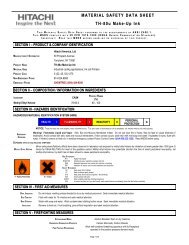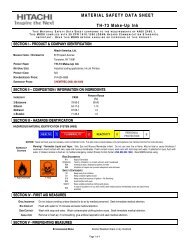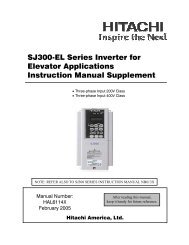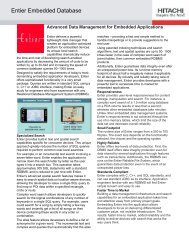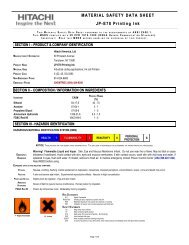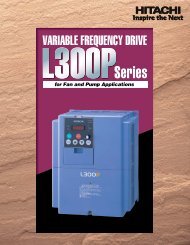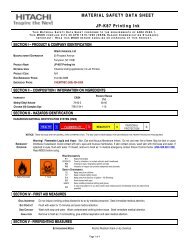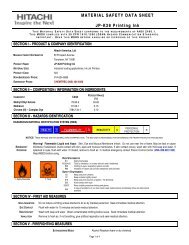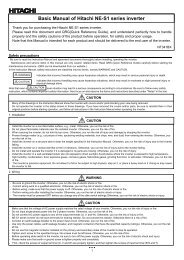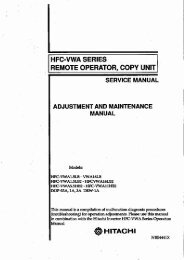SJ700-2 Instruction Manual NT204DX - Hitachi America, Ltd.
SJ700-2 Instruction Manual NT204DX - Hitachi America, Ltd.
SJ700-2 Instruction Manual NT204DX - Hitachi America, Ltd.
Create successful ePaper yourself
Turn your PDF publications into a flip-book with our unique Google optimized e-Paper software.
Chapter 4 Explanation of Functions<br />
4.2.102 Torque LAD stop function<br />
The torque LAD stop function is effective when "03" (sensorless<br />
vector control), "04" (0Hz-range sensorless vector control), or<br />
"05" (vector control with sensor) is specified for the V/F<br />
characteristic curve selection (A044/A244). This function<br />
temporarily stops the frequency-based deceleration function<br />
(LAD) when the torque limitation function operates.<br />
Related code<br />
A044/A244: V/F characteristic curve selection,<br />
1st/2nd motors<br />
b040: Torque limit selection<br />
b041 to b044: Torque limits (1) to (4)<br />
b045: Torque limit LADSTOP enable<br />
Item Function code Data or range of data Description<br />
03 Sensorless vector control<br />
A044/A244<br />
04 0Hz-range sensorless vector control<br />
05 Vector control with sensor (not available for A244)<br />
00 Quadrant-specific setting mode<br />
01 Terminal-switching mode<br />
b040<br />
02 Analog input mode<br />
03 Option 1 mode<br />
V/F characteristic<br />
curve selection<br />
Torque limit<br />
selection<br />
04 Option 2 mode<br />
Torque limit (1) b041 0 to 200 (%)<br />
Forward powering (in quadrant-specific setting<br />
mode)<br />
Torque limit (2) b042 0 to 200 (%)<br />
Reverse regeneration (in quadrant-specific<br />
setting mode)<br />
Torque limit (3) b043 0 to 200 (%)<br />
Reverse powering (in quadrant-specific setting<br />
mode)<br />
Torque limit (4) b044 0 to 200 (%)<br />
Forward regeneration (in quadrant-specific<br />
setting mode)<br />
Torque limit<br />
00 Disabling the torque LAD stop function<br />
b045<br />
LADSTOP enable<br />
01 Enabling the torque LAD stop function<br />
40 Whether to enable torque limitation<br />
Terminal function C001 to C008<br />
41 Torque limit switch 1<br />
42 Torque limit switch 2<br />
4.2.103 High-torque multi-motor operation<br />
The high-torque multi-motor operation function allows you to<br />
make a single inverter operate the two motors (having the<br />
same specifications) that drive a single load (machine). This<br />
function is effective when the V/F characteristic curve selection<br />
is the sensorless vector control or 0Hz-range sensorless<br />
control.<br />
To use the function, adjust the inverter settings required for the<br />
sensorless vector control (see Section 4.2.92) or 0Hz-range<br />
sensorless control (see Section 4.2.93), except for the motor<br />
constant settings. Adjust the motor constants as follows:<br />
1) For constants R1, R2, and L, specify a value half as large<br />
as that normally specified for one motor.<br />
2) For constant Io, specify a value twice as large as that<br />
normally specified for one motor.<br />
3) For constant J, specify a value half as large as the total<br />
moment of inertia of the two motors and the load connected<br />
to them.<br />
Related code<br />
A044/A244: V/F characteristic curve selection,<br />
1st/2nd motors<br />
F001: Output frequency setting<br />
b040: Torque limit selection<br />
b041 to b044: Torque limits (1) to (4)<br />
H002/H202: Motor data selection, 1st/2nd motors<br />
H003/H203: Motor capacity, 1st/2nd motors<br />
H004/H204: Motor poles setting, 1st/2nd motors<br />
H005/H205: Motor speed constant, 1st/2nd motors<br />
H020/H220: Motor constant R1, 1st/2nd motors<br />
H021/H221: Motor constant R2, 1st/2nd motors<br />
H022/H222: Motor constant L, 1st/2nd motors<br />
H023/H223: Motor constant Io, 1st/2nd motors<br />
H024/H224: Motor constant J, 1st/2nd motors<br />
H050/H250: PI proportional gain, 1st/2nd motors<br />
H051/H251: PI integral gain, 1st/2nd motors<br />
H052/H252: P proportional gain setting, 1st/2nd<br />
motors<br />
Select the motor capacity that is closest to the collective capacity of both motors.<br />
If different loads are driven by the two motors operated by the inverter, the load fluctuations on one motor<br />
may change the other motor's operation status, and the inverter may be unable to normally control the<br />
motors. Be sure to configure your system so that the motors drive only a single load or multiple loads that<br />
can, at least, be recognized as a single load.<br />
4 - 95




